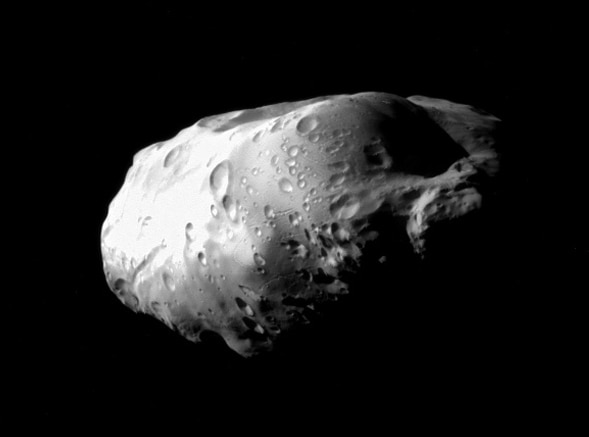Create a free profile to get unlimited access to exclusive videos, sweepstakes, and more!
The Modern Prometheus

Pluto and Mars may be getting the lion’s share of the planetary news lately, but the Cassini spacecraft is still orbiting Saturn and returning devastatingly beautiful images. Every picture it takes of one of Saturn’s huge and diverse panoply of moons is nothing short of amazing, and a new portrait of Prometheus had me gasping out loud.
Behold:
This image is seriously cool, for a lot of reasons. Prometheus is potato-shaped, about 136 km long. It’s lumpier than your standard spud, though, and riddled with craters.
This image was taken when Cassini was 37,000 km from the tiny moon, and I thought for a moment this was the closest the spacecraft ever got. But in early 2010 it was actually 34,000 km away when it snapped a moody shot of Prometheus. However, at that time the Sun was nearly behind the moon, so most of it seen was dark. Another pass, in 2009, brought it 57,000 km away, but this time the Sun was nearly behind Cassini, fully illuminating the moon. That tends to downplay surface features like craters, so Prometheus looks oddly bereft of details.
This new picture nailed it. The angle of the Sun is perfect, enough to give us a good view, but at an angle that emphasizes craters. And the craters do look odd, don’t they? Soft. That’s because the surface of Prometheus is covered with dust of some kind, smoothing out the sharp edges and filling the crater bottoms a bit.
Prometheus orbits Saturn just inside the narrow F ring, and the moon’s gravity pokes and prods at the ring particles, creating lovely effects. Being that close to the ring means Prometheus is accumulating finer particles (as my friend Emily Lakdawalla points out, many moons embedded in the rings gather dust). I wonder if it might even be getting lightly “sandblasted” by them; note that there aren’t many small craters on the surface. Moons farther out from the rings are saturated with craters of all sizes, but Prometheus isn’t. Something must be acting on it to erase or bury them.
But there are some smaller craters, including a lovely crater chain almost smack dab in the center of the image (with hints of at least one more chain nearby). That’s usually caused by secondary impacts; material ejected from a bigger impact that then falls to the surface. Prometheus doesn’t have much gravity, though, so I have to wonder if instead it got hit by a small body that got disrupted by Saturn’s gravity, like Shoemaker-Levy 9 before it hit Jupiter. I’m completely speculating here, so don’t take this as gospel. I’m just thinking out loud, which is fun to do with new images.
One more fun thing: I cropped the original image to make the moon as big as possible on your screen. But I had to make a sacrifice to do that, leaving out something very important: The F ring!
That’s the original, with the fuzzy ring in the background. Prometheus is a shepherd moon: Its gravity helps keep the ring particles in the ring. Through the odd dance of gravity and orbital motions, any particle that wanders out of the ring feels a tug back into it as the moon passes.
I was wondering if this might be the last pass Cassini will make of Prometheus; the spacecraft’s mission is due to end in September 2017. But there’s one pass in 2016 and quite a few in 2017, including several at about the same distance as this last one. So we’ll be seeing even more images of this tiny icy moon in the near future. That makes me happy; the more angles we get on it at different lighting, the better we’ll understand it. It would take a lifetime to understand even one given object in Saturn’s retinue, but oh, what a lifetime that would be.


























